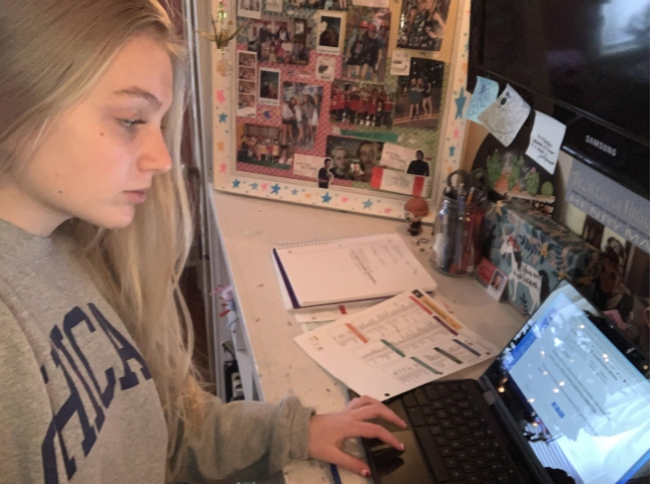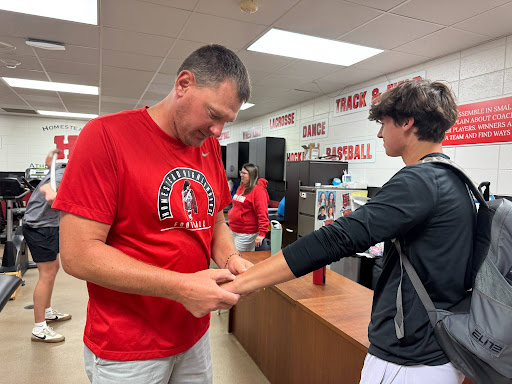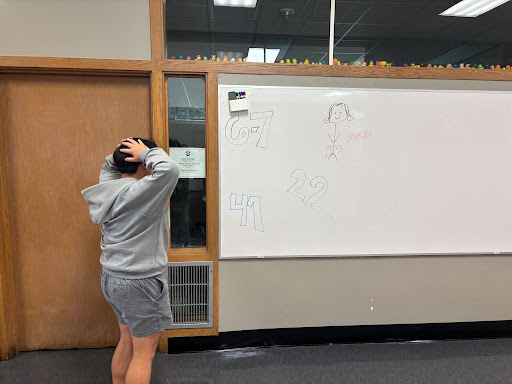The impacts and future of online learning
Greta Diehl, sophomore, completes her Spanish class work from home. Diehl’s family decided that online learning would be the safest option for them in order to help lower the risk of bringing COVID-19 into their home. “Working on school at home gets tough when you have to train your brain to focus in an environment that you usually relax in. Other than that, it has not had many negative effects on me,” Diehl said.
Ever since COVID-19 was declared a pandemic in March 2020 by the World Health Organization (WHO), the world has undergone many changes, both positive and negative. One such change is virtual learning.
With the contagion factor of COVID-19, many students have opted to stay home in order to lower their risk of contracting the virus. In fact, since online learning was initiated, the United States Census Bureau reported that “nearly 93% of people in households with school-age children reported their children engaged in some form of ‘distance learning’” over the course of the pandemic.
Besides the obvious fact of staying away from the virus, online students are provided with other benefits, such as more sleep, a more flexible schedule and physical and mental breaks.
In earlier times, this form of learning would not have been possible, but with the technology of today, it is. Students are able to access the same information and resources as their in-person classmates, as long as they can obtain a computer and Internet connection. However, as USA Facts stated, “4.4 million households with students still lack consistent access to a computer and 3.7 million lack internet access.” These students who do not have the access are losing their education, impacting how they will be able to support themselves in the future.
Along with the disadvantages that come with the technology, online students are also impacted by a lack of social interaction. As reporter Timothy A. Rowland from Vocal said, “The in person contact and interactions are as much a part of learning and growing as a person, as the lessons themselves are.”
Being at home makes it more difficult to interact with their classmates, which can ultimately lead to feelings of isolation and depression, as well as a slide backwards in terms of students’ emotional growth.
However, the impact of online learning is different for every student. Terry Carr, the social-emotional coach at Homestead, said that she believes the success of online students depends on their ability to ask for help. “I think that some students aren’t as good at self-advocacy, and I think those that are are certainly receiving the same amount of support. I think those that have a hard time reaching out to the teacher or the teacher reaching out to them, they are just embarrassed to ask questions and feel stupid, and that kind of thing. So, I don’t think it is anyone’s fault, I just think that there are certain circumstances that sometimes make it harder to support distance learning,” Carr said.
With these findings arising after nearly a year of online learning due to the pandemic, people have begun to question whether or not online learning will become the way of school in the future.
As the pandemic continues, people are continuing to evaluate which option is best for them, and the effects it imposes. Many virtual students at Homestead acknowledge both the positives and negatives that accompany online learning, and what they plan to do once the pandemic is over and they have the option to return to school. One of these positives is the flexibility that online schooling provides.
“I love having a certain time to sit and listen, but also when they [the teachers] let us go to work on our own. It gives me an opportunity to manage my work time better,” Greta Diehl, a virtual sophomore, said.
This aspect of virtual schooling may pull some students to join virtual classes in the future if they have busy schedules or other activities that make it harder for them to attend school or complete classwork at a certain time.
Students also get more physical benefits, such as more sleep and time to get ready in the morning. “I’ve always been a late riser, so pre-COVID I would wake up and race out the door. Now that I don’t have to race out the door, I have more time to eat/get ready for the day before class,” Diehl said.
This may make online learning ideal for those who feel tired and lethargic in the morning, allowing them to be more productive during the school day.However, many students miss the social interaction of school. Eatai Sasson, an online senior, is one of these students. “I chose to do online learning because my parents are high-risk, and I didn’t want to take any chances of bringing COVID home,” Sasson said.
Sasson said that while he enjoys the chance to get more sleep and eat whenever he wants, he much prefers in-person learning. “It’s a little lonely being online. Seeing friends every day is what makes school fun and by being online you’re taking the best part of school away.”
As a result of this, some students may remain in-person so that they have the opportunity to see their friends in the halls every day.
Despite all of the pros and cons, both Diehl and Sasson said that they plan on returning to in-person classes once it is safe again.
“I would return in-person 100%. I hope I never have to take an online class again once the pandemic is over,” Sasson said.Until then, both staff and families wonder just how popular online learning will become after the pandemic.
Carr said that she has thought about the possibility of this along with meetings for her job. “With a meeting I might not be able to get to because of driving…I may be able to go because I can Zoom into it.”
So, despite all of the changes within the past year, perhaps even more are to come in the future of education.

Maura Whitaker is a sophomore at Homestead High School. She loves math, science, and writing, and is a GEMS board member. She also partakes in She’s...

Greta Diehl is a senior at Homestead High School. She is the president of table tennis club and frequently attends Teens Against Trafficking Club. Outside...






